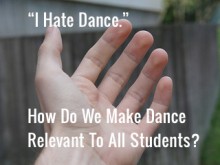Right before break, a fifth grade boy chose not to participate at all in my 30 minute class.
At all.
We had a familiar conversation that ended with him saying, “I hate dance. I am never going to dance so I don’t see what I have learn in this class.” And then the bell rang, the school day was over and our two week Winter break began. The conversation has been playing in my mind since.
 It isn’t that he or other students haven’t said the same or similar statements before.
It isn’t that he or other students haven’t said the same or similar statements before.
In fact, I recently spoke to this student’s dad about his general distaste for dance. His dad referenced this student’s involvement in soccer and suggested I use that when teaching the value of dance. Thing is, I don’t really think this kid enjoys soccer that much, either- at least not in the way that connecting dance to the sport would excite him. My sense is that he enjoys soccer for the steam he blows off- not necessarily the skills he is developing in a technical sense.
Given time and opportunity, I can usually bring these students around to seeing that it is worth listening and actively watching, and usually they end up moving. This latest exchange has prompted a larger scale reflection, however.
I think same old arguments for ‘why students should dance’ used 10 and 15 years ago don’t really work as well now.
Life is different. The learning environment is different. Students’ needs are different.
I wonder – how do we make dance relevant to all students?
The discovery of movement is a glorious thing. It is what keeps us dancing and talking about dance, isn’t it? But what about those that don’t have an innate love for dance and need a reason to buy in? What do we have in common with them?
Bodies and a need to communicate.
Over the last few months, I have revisited some stellar books that are shifting my attitudes about teaching and right now I see an opportunity and a reason to put some new ideas into play.
Here is my recent reading list:
Moving Lessons: Margaret H’Doubler and the Beginning of Dance in American Education by Janice Ross
Anna Halprin: Experience as Dance by Janice Ross
Teaching Dance Studies Edited by Judith Chazin-Bennahum
The Dance in Theory by John Martin
I Want to Be Ready: Improvised Dance as a Practice of Freedom by Danielle Goldman
The Body Eclectic: Evolving Practices in Dance Training
Theory to Practice
Creative movement has been a common element in my teaching of all ages for the problem-solving, higher-order thinking it involves and promotes. Improvisation, as a more formalized link to choreography has also been a natural and important element to my classes, particularly for middle school and high school students.
This semester, however, I am inspired to use improvisation to bring awareness to human movement potential, to treat it as a creative product and not simply a source for generating movement. I plan to introduce this approach even to my youngest students in ways we haven’t moved creatively before.
Why not give students time and space to process how their body works, as it is inclined to work.
Let’s honor our bodies as source material as well as the vehicle for blowing off steam.
Let’s value movement for its technical properties as well as purely functional ones.
Let’s permit students’ bodies do the thinking for them and teach them to value that very thinking- at least 30 minutes a week.
We want to hear your thoughts!
How do you make dance relevant to the students in your classroom?
Heather Vaughan-Southard MFA, is a choreographer, dance educator, and performer based in Michigan. She currently directs the dance program at the Everett High School Visual and Performing Arts Magnet in Lansing. With the philosophy of teaching dance as a liberal art, Ms. Vaughan-Southard collaborates with numerous arts and education organizations throughout the state. She has danced professionally in Chicago, Detroit, Los Angeles, and New York and has performed works by Mia Michaels, Lar Lubovitch, Donald McKayle, Billy Siegenfeld, Alexandra Beller, Debra Levasseur-Lottman, and Bob Fosse. As a choreographer, her work has been credited by the Los Angeles Times for “creating heat.” She has recently choreographed for the dance programs at Michigan State University, Grand Valley State University, Lansing Community College and is the former dance professor at Albion College. She is a regular guest artist and blogger for Dance in the Annex, an innovative dance community in Grand Rapids. Heather received her MFA in Dance from the University of Michigan, BFA in Dance from Western Michigan University and K-12 certification in Dance from Wayne State University. Read Heather’s posts.



